Reggio Calabria is home to many species of birds, both migratory and resident. This Mediterranean region in the south of Italy provides a unique habitat, full of natural wonders and stunning landscapes.
From the wide open plains to the lush forests and rugged mountains, there is plenty of opportunity to explore and observe the local wildlife. From the majestic Griffon Vulture to the graceful Kingfisher, Reggio Calabria is full of remarkable birds to discover.
Whether you are a professional ornithologist or a passionate birdwatcher, Reggio Calabria is the perfect destination for a bird-watching adventure.
1. European Turtle Dove
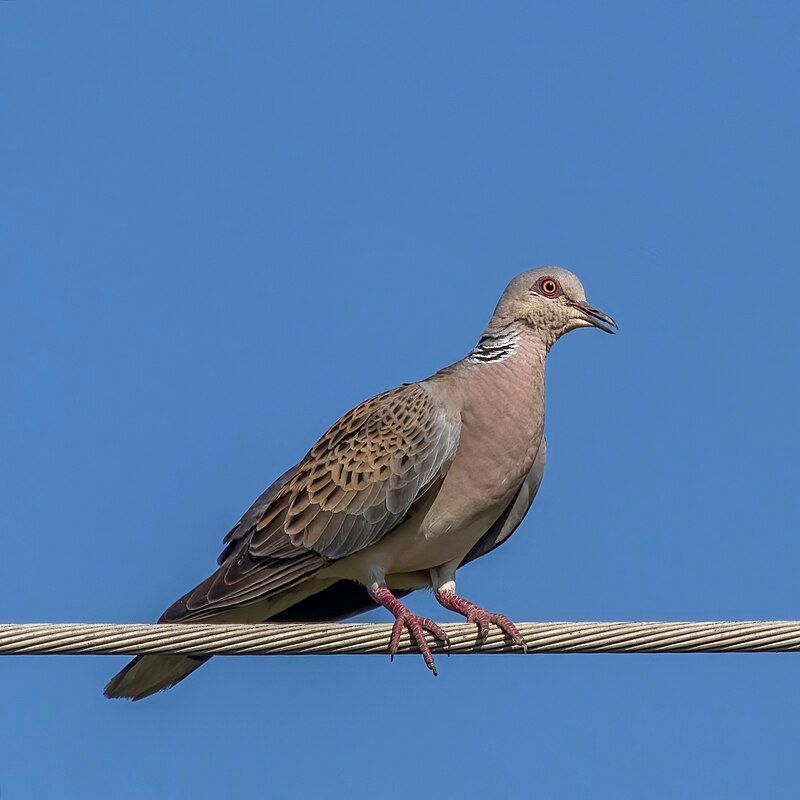
The European Turtle Dove is a species of bird that belongs to the Columbidae family, which also includes doves and pigeons.
It is native to the Palearctic region, which encompasses a large area that includes North Africa, and it breeds over a wide area of the southwestern portion of this region.
During the winter months, these birds migrate south to the northern part of Sub-Saharan Africa to take advantage of the warmer temperatures. The migration of the European Turtle Dove is an important part of its life cycle, and it helps to ensure the survival of the species.
The birds generally return to their breeding grounds in the spring, when the weather warms up and food sources become more plentiful. This species of dove is an important part of the ecosystem, and it plays a vital role in the natural balance of the region.
| Kingdom | Animalia |
| Phylum | Chordata |
| Class | Aves |
| Order | Columbiformes |
| Family | Columbidae |
| Genus | Streptopelia |
| Species | S. turtur |
2. Common Wood Pigeon
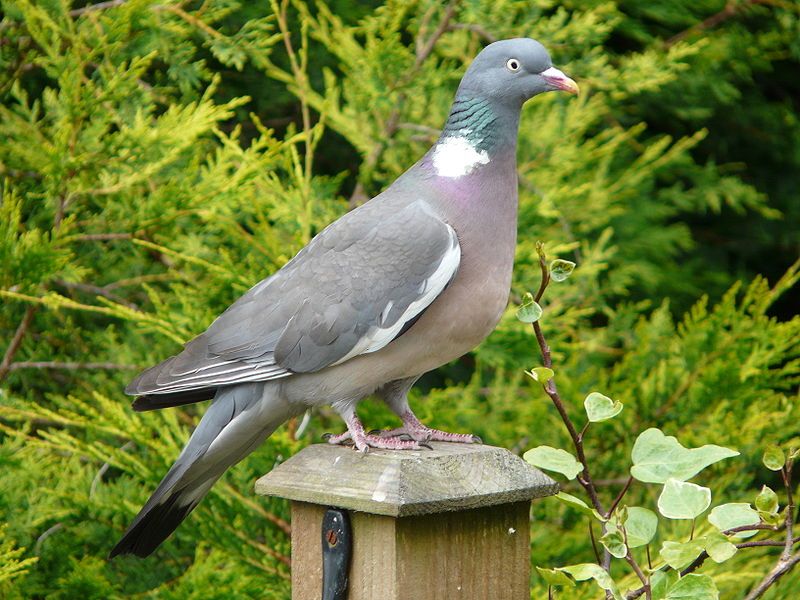
The common wood pigeon is one of the most recognizable birds in the world and is found in many parts of the world.
It is a large species in the dove and pigeon family and is native to the western Palearctic, which includes most of Europe, parts of North Africa, and the Middle East.
It is a member of the genus Columba, which includes closely related species such as the rock dove. The common wood pigeon is a large bird, with a wingspan of up to 80 centimeters and a body length of up to 40 centimeters.
Its plumage is mostly grey-brown, with white patches on its wings and neck. The wood pigeon is a strong flier and can migrate long distances in search of food.
It is an omnivorous bird, feeding on seeds, fruits, and insects. The common wood pigeon is a social species and is often seen in large flocks in its natural habitat. It is also a popular species for hunting and is extensively bred for food.
The wood pigeon is considered an agricultural pest in some countries, due to its large appetite for crops such as cereals and fruit.
| Kingdom | Animalia |
| Phylum | Chordata |
| Class | Aves |
| Order | Columbiformes |
| Family | Columbidae |
| Genus | Columba |
| Species | C. palumbus |
3. European Nightjar
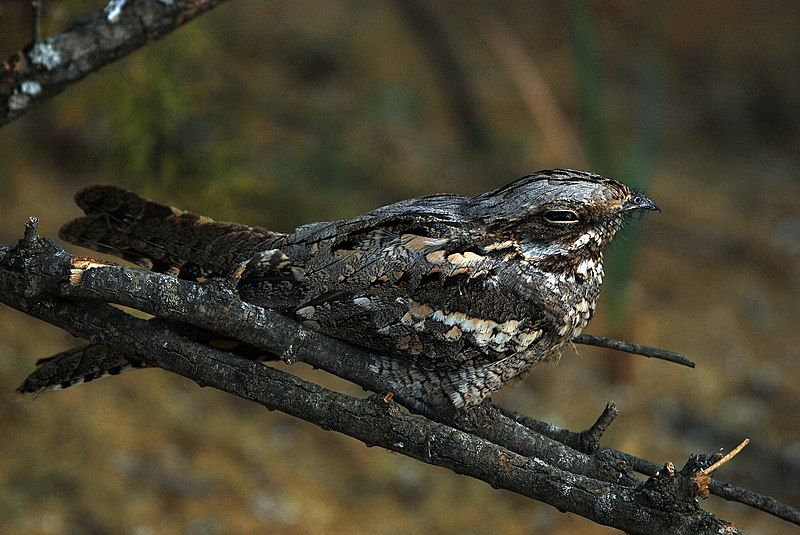
The European nightjar is a species of bird found in several regions across the world. It is a part of the nightjar family and is found in Europe, the Palearctic, Mongolia, and Northwestern China.
It is a crepuscular and nocturnal bird, meaning that it is most active during the twilight hours of dawn and dusk and during the night. It is also referred to as a common goatsucker, Eurasian nightjar, or just nightjar.
Its diet consists mainly of insects and it is known for its camouflage colouring which is mainly brown and grey with streaks of white on its wings and body.
It is also distinguished by its long pointed wings and short tail. The European nightjar is a migratory bird and it breeds in the summer. During the breeding season, the male performs a courtship display by flying in circles and producing a distinctive churring sound.
The female will then lay her eggs in a shallow scrape on the ground and the pair will take turns incubating them. The European nightjar is an important part of the local ecology, as it helps control insect populations.
It is classified as a species of least concern on the IUCN Red List and its population is thought to be stable.
| Kingdom | Animalia |
| Phylum | Chordata |
| Class | Aves |
| Clade | Strisores |
| Order | Caprimulgiformes |
| Family | Caprimulgidae |
| Genus | Caprimulgus |
| Species | C. europaeus |
4. Common Quail
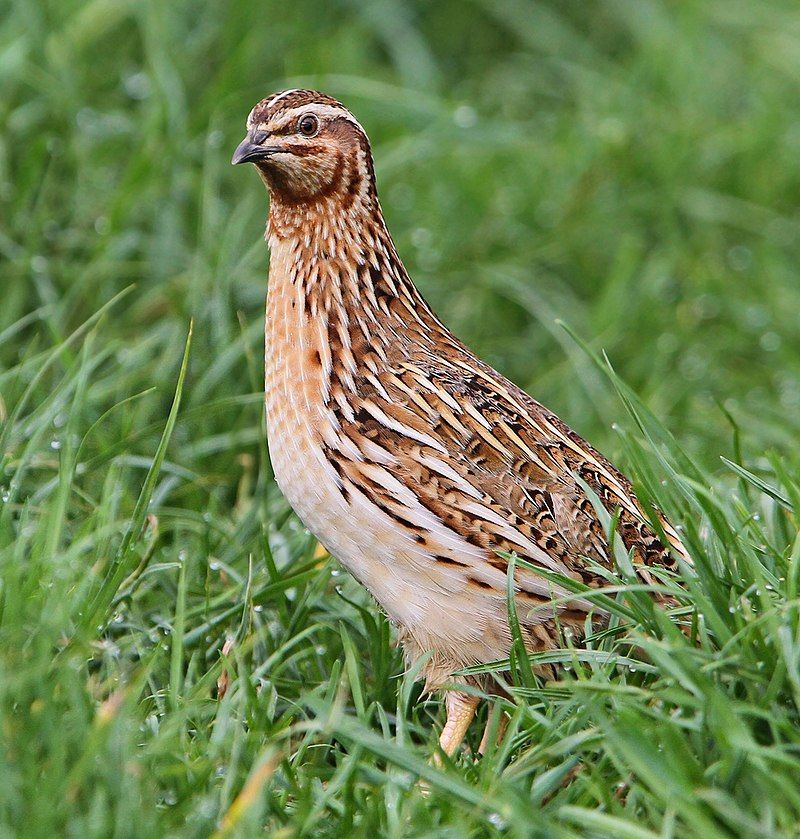
The common quail, or European quail, is a small bird belonging to the pheasant family Phasianidae. It is a migratory bird, breeding in western Palearctic regions and wintering in Africa and southern India.
This species of quail is mostly heard rather than seen, due to its distinctive call of three repeated chirps. The common quail is a small bird, typically measuring around 20 cm in length.
It is typically brown in color, although the males have a more distinctive pattern with dark brown and black stripes on the head and neck.
The bird’s wings are short and rounded, making it unable to fly for long distances. The common quail feeds on small insects, seeds and grains, and is mainly found on the ground. It builds its nest in the ground, among grasses or low shrubs.
The female lays around 10-15 eggs, which are incubated by both parents for around a month before hatching. The chicks are able to fly within two weeks of hatching. The common quail is a social bird, often seen in large flocks during the winter months.
They are usually very noisy, with their characteristic call of three repeated chirps. This call is used to communicate with other birds and helps them to keep in touch while they are migrating. The common quail is an important game bird, hunted for its meat and eggs.
It is also kept as a pet by some people, due to its tame and friendly nature. The species is not considered to be threatened, however, its population is declining in some areas due to habitat loss and hunting.
| Kingdom | Animalia |
| Phylum | Chordata |
| Class | Aves |
| Order | Galliformes |
| Family | Phasianidae |
| Genus | Coturnix |
| Species | C. coturnix |
5. Phasianidae
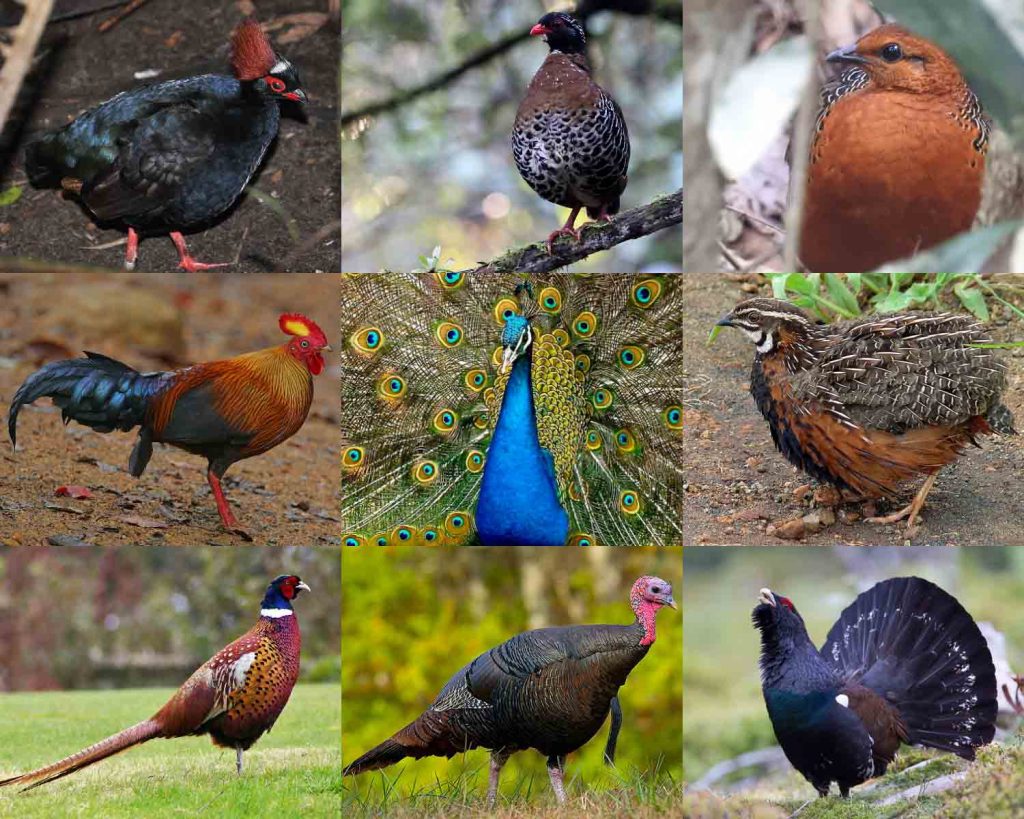
Source: Wikipedia
The Phasianidae family is a large group of birds that includes a variety of species. These ground-living birds are heavy and include 185 species divided into 54 different genera.
Many of the birds in this family are popular gamebirds, including pheasants, partridges, junglefowl, chickens, turkeys, Old World quail, and peafowl. Each species has its own unique characteristics, such as size, habitat, and behavior.
Pheasants, partridges, and junglefowl are known for their vibrant plumage and long, pointed tail feathers. These birds are found in a variety of habitats, from grasslands to forests. Chickens, turkeys, and Old World quail are smaller than the other birds in this family.
They are often raised for their meat and eggs and are kept as pets in some cultures. Peafowl, commonly known as peacocks, are known for their extravagant tail feathers and their loud calls.
They are found in tropical climates, and their bright colors make them a popular choice for ornamental birds. No matter what species, the Phasianidae family offers a variety of birds to enjoy.
From the vibrant colors of pheasants to the loud calls of the peacock, these birds are a delight to watch and listen to.
| Kingdom | Animalia |
| Phylum | Chordata |
| Class | Aves |
| Order | Galliformes |
| Family | Phasianidae |
6. Eurasian Wigeon
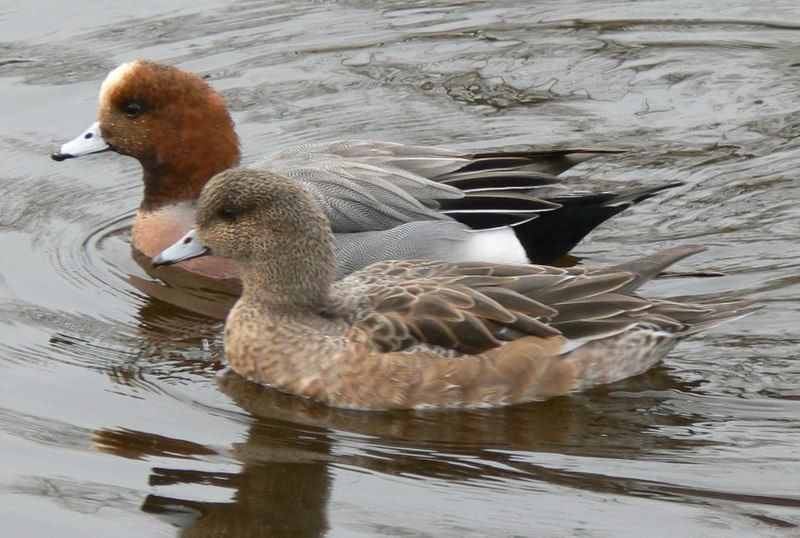
The Eurasian wigeon, also known as the European wigeon, widgeon or simply the wigeon, is a species of duck belonging to the dabbling duck genus Mareca. This species is widely distributed across the Palearctic region, spanning much of Europe and Asia.
It is also one of the most common duck species found in these regions, with its numbers being higher than many other species of duck. The Eurasian wigeon has a distinct appearance, having a white breast and belly, a greyish-brown back, and a brown head with a white crown.
It also has a white patch at the base of its neck and a white line extending from its eye downward towards its bill. The male and female Eurasian wigeon also have similar plumage, although the males usually have brighter colors.
The Eurasian wigeon’s diet consists mainly of aquatic vegetation, as well as some seeds, insects, and crustaceans. It is a dabbling duck, meaning that it feeds at the surface of the water by tipping its body forward and submerging its head and neck.
This species is also known to form large flocks when feeding or migrating, and it can be found in both freshwater and coastal habitats. The Eurasian wigeon is a popular species for birdwatchers, and its population is currently stable and not threatened.
It is also hunted for sport in some areas, although hunting is regulated by local laws. With its bright colors and large flocks, the Eurasian wigeon is a beautiful sight to behold and a reminder of the diversity of species in the Palearctic region.
| Kingdom | Animalia |
| Phylum | Chordata |
| Class | Aves |
| Order | Anseriformes |
| Family | Anatidae |
| Genus | Mareca |
| Species | M. penelope |
7. Rock Partridge
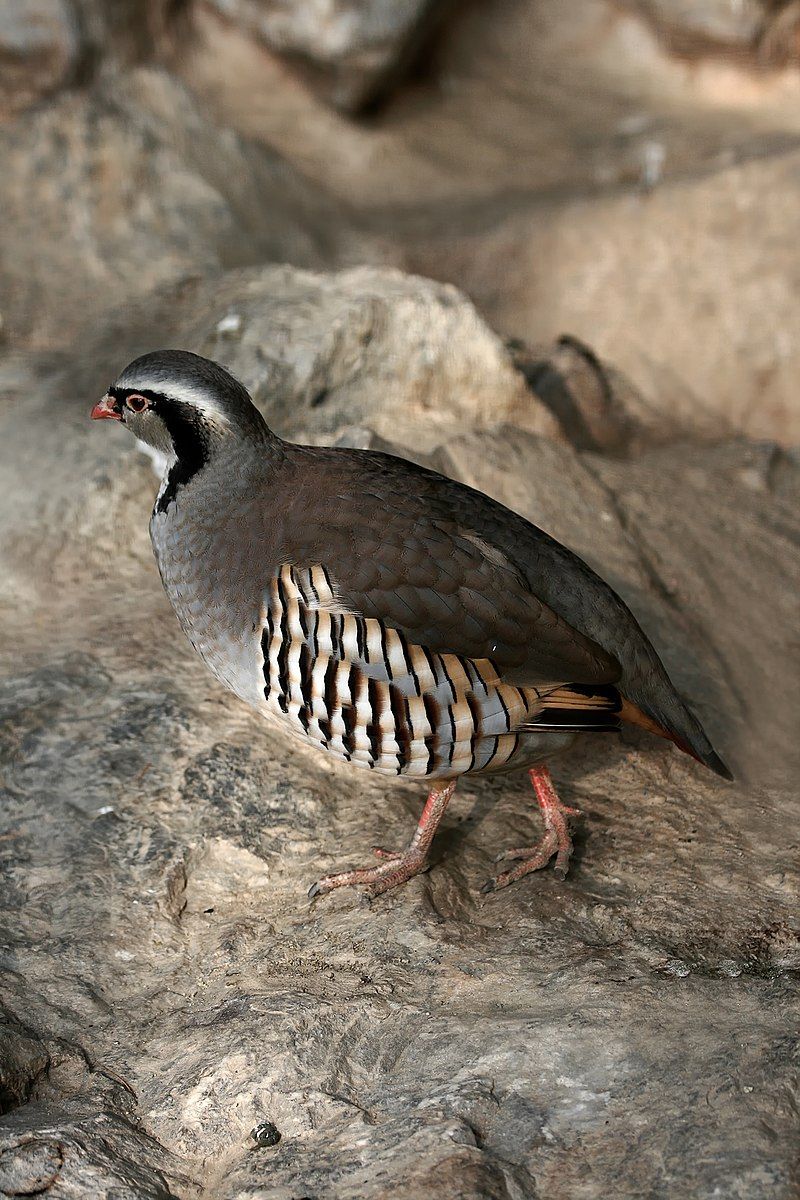
The rock partridge is a species of gamebird belonging to the Phasianidae family, which is part of the order Galliformes. It is native to southern Europe and is closely related to the chukar partridge, A. chukar.
These two species are very similar in terms of appearance, behavior, and habitat. The rock partridge is a medium-sized bird with a brown-black back, a white collar, and a blue-gray breast. It has a short tail and long legs, and its song is a loud, repeated “cluck-cluck”.
The rock partridge typically inhabits rocky areas, such as cliffs, mountain slopes, and gorges, where it feeds on insects, seeds, and berries. It is known to form small flocks, and in the winter it may congregate in larger numbers.
The rock partridge is prized by hunters for its meat and is also a popular gamebird in aviculture.
| Kingdom | Animalia |
| Phylum | Chordata |
| Class | Aves |
| Order | Galliformes |
| Family | Phasianidae |
| Genus | Alectoris |
| Species | A. graeca |
8. Eurasian Teal
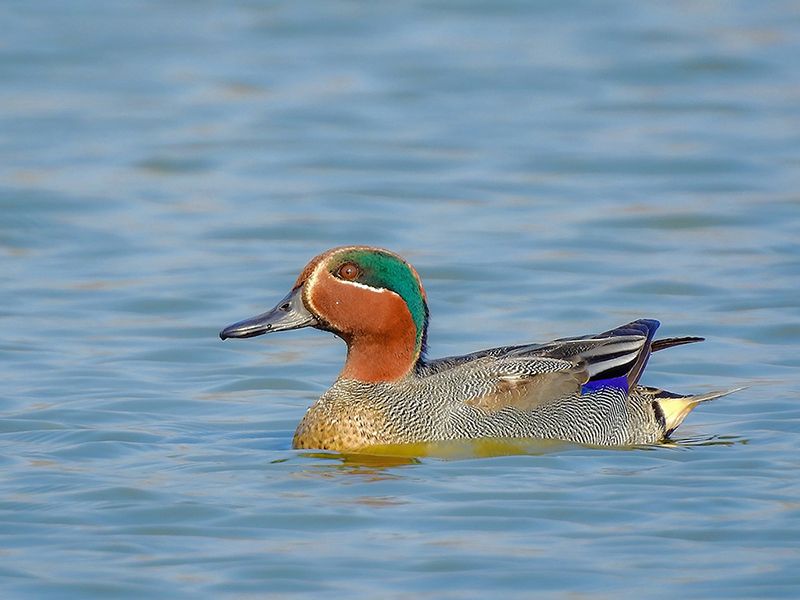
The Eurasian teal is a species of duck native to the temperate regions of Eurasia. It is a migratory bird, meaning that it will move south for the winter. It is commonly referred to as a common teal or Eurasian green-winged teal due to its bright green feathers.
The Eurasian teal is the most common and widespread of the small dabbling ducks, making it a distinct species among its peers. It is a fairly small duck, with males usually ranging from 40-50 cm in length and weighing up to 600 grams.
The Eurasian teal is also known for its distinctive call, which is a sharp, whistling “tke-tke-tke.” The Eurasian teal is a highly adaptive species, capable of inhabiting a variety of different habitats.
It can be found in wetlands, marshes, shallow lakes, and even adjacent to fields and woods. The duck is omnivorous and feeds on a variety of plants, insects, and fish.
Its diet also includes aquatic invertebrates, such as mollusks and crustaceans. In the wild, the Eurasian teal typically nests in tree cavities or on the ground, laying around 10 eggs. The female will incubate the eggs for around three weeks until they hatch.
The chicks are able to fly within two months and will migrate with their parents in the winter. The Eurasian teal is a popular game bird and is hunted by humans in many parts of its range.
It is also a popular bird for birdwatchers, as it is fairly easy to observe in its natural habitat. The population of the Eurasian teal is stable, and the species is not currently considered to be at risk of extinction.
| Kingdom | Animalia |
| Phylum | Chordata |
| Class | Aves |
| Order | Anseriformes |
| Family | Anatidae |
| Genus | Anas |
| Species | A. crecca |
9. Ferruginous Duck
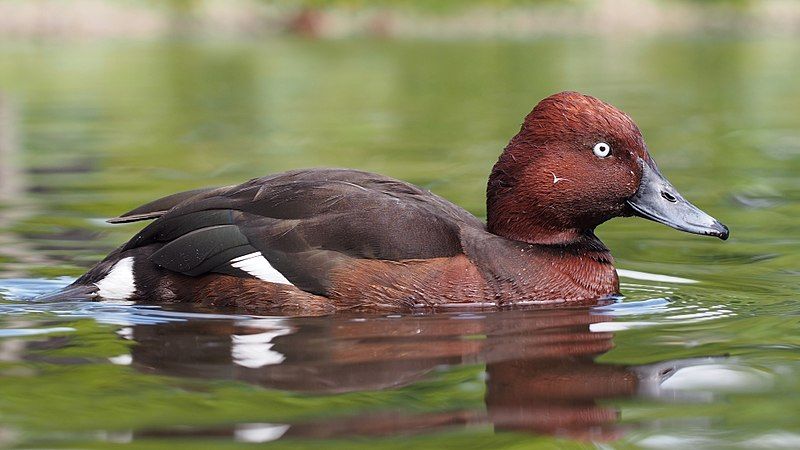
The ferruginous duck is a species of medium-sized diving duck that is found in Eurosiberia. It is also known by several other names including ferruginous pochard, common white-eye, and white-eyed pochard.
The scientific name of the species is derived from two Greek words: aithuia, which refers to an unidentified seabird mentioned by authors such as Hesychius and Aristotle, and nyrok, which is the Russian name for a duck. The ferruginous duck is a species that is of conservation concern and is listed as vulnerable by the IUCN.
It prefers to inhabit shallow lakes, marshy areas, and slow-flowing rivers and feeds mainly on aquatic plants, small fishes, and invertebrates.
The species is also known to form large flocks and is very social. The ferruginous duck is a species that is not well-studied, so there is still much to learn about its ecology and behavior.
However, what is known is that the ferruginous duck is a species that is important to the ecosystem in Eurosiberia and one that needs to be protected.
| Kingdom | Animalia |
| Phylum | Chordata |
| Class | Aves |
| Order | Anseriformes |
| Family | Anatidae |
| Genus | Aythya |
| Species | A. nyroca |
10. Black-Necked Grebe
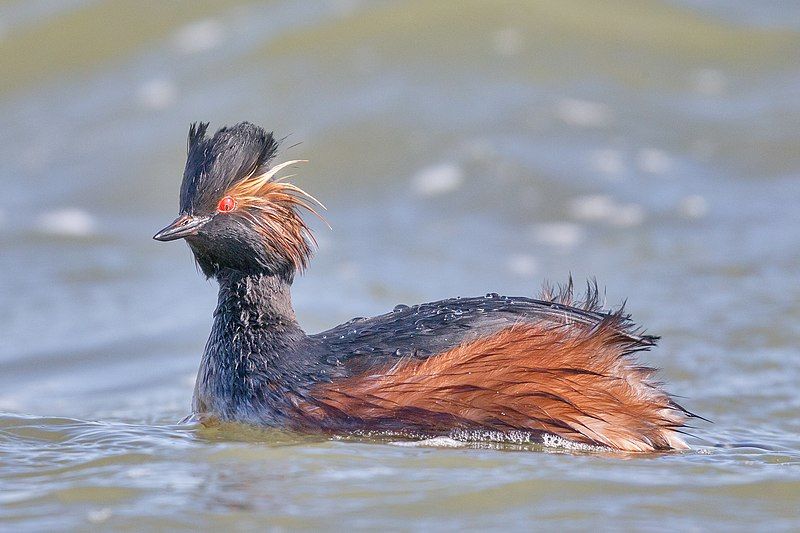
The black-necked grebe or eared grebe is a species of water bird belonging to the grebe family of birds. It was first identified in 1831 by the German naturalist Christian Ludwig Brehm.
At present, there are three distinct subspecies of the black-necked grebe, with the nominate subspecies being the most widespread. The black-necked grebe is a small to medium-sized bird, typically measuring between 24 to 28 cm in length.
Its plumage is predominantly white in color, with the head and neck being black. Its feet are also black in color and its bill is short and stubby. It has two distinctive ear tufts which are blackish in color and are situated close to the eyes.
The black-necked grebe is a mostly aquatic bird, inhabiting freshwater environments such as lakes, marshes, and rivers. It is an excellent swimmer and diver and feeds mainly on small fish, aquatic insects, and crustaceans.
It nests in shallow water, typically in the form of a floating platform made from vegetation. The black-necked grebe is a migratory species, with many populations moving south during the winter months.
It is considered to be an endangered species due to habitat loss and hunting and is currently listed as Vulnerable on the IUCN Red List.
| Kingdom | Animalia |
| Phylum | Chordata |
| Class | Aves |
| Order | Podicipediformes |
| Family | Podicipedidae |
| Genus | Podiceps |
| Species | P. nigricollis |
11. Greater Flamingo
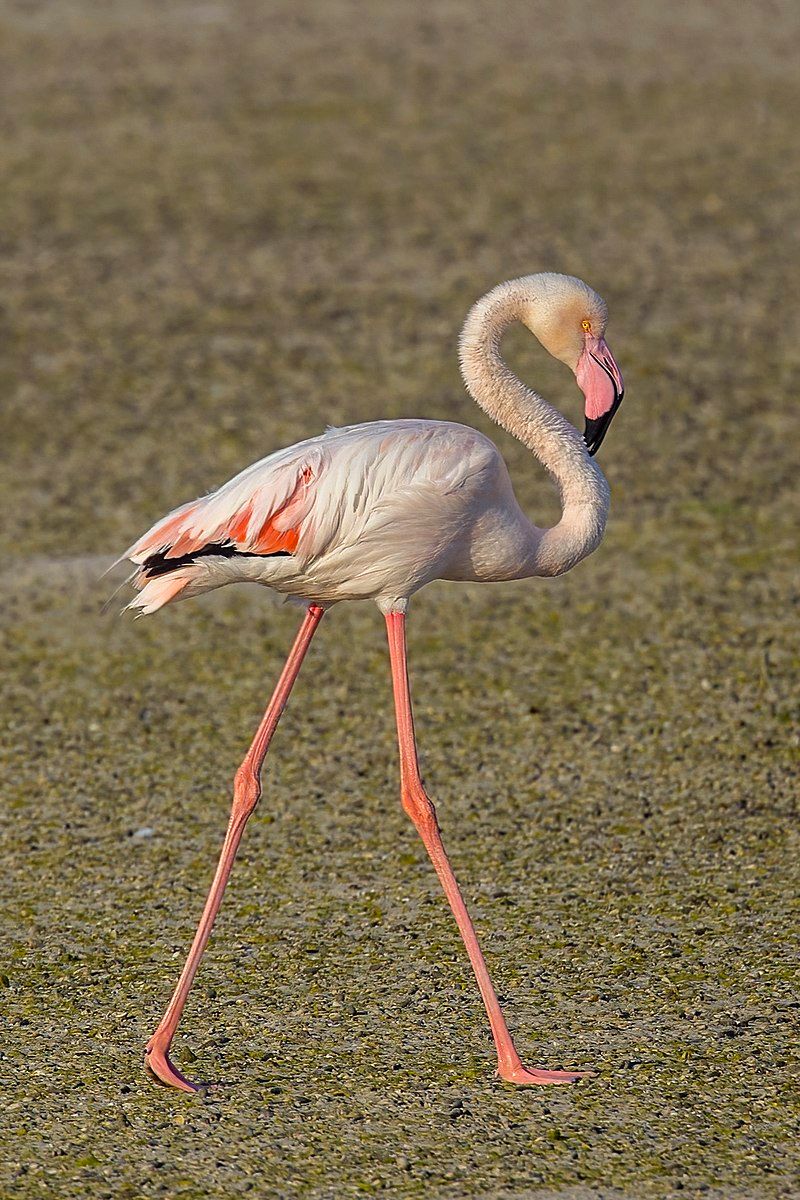
The greater flamingo is one of the most widespread and largest species of the flamingo family.
This species can be found living in a variety of habitats in the Old World, ranging from Northern and Sub-Saharan Africa to the Indian Subcontinent, the Middle East, the Levant, the Persian Gulf, the Gulf of Aden, the Red Sea, and the Mediterranean countries of Southern Europe.
This wide range of habitats allows the greater flamingo to take advantage of a variety of resources, such as food, water, and shelter. The greater flamingo is adapted to living in warmer climates and can be found in coastal lagoons, brackish lakes, estuaries, shallow seas, and mudflats as well as in the open sea.
They feed on a variety of small aquatic organisms such as fish, mollusks, crustaceans, and aquatic plants. Greater flamingos are social birds and often congregate in large flocks.
They are also highly vocal, with a variety of complex vocalizations used for communication. The greater flamingo is an iconic species that has become a symbol of beauty and grace.
Its stunning pink and white plumage, long graceful neck, and graceful movements make it an impressive sight to behold.
The greater flamingo is an important species, both culturally and ecologically, and is a species of conservation concern due to its declining population in certain parts of its range.
| Kingdom | Animalia |
| Phylum | Chordata |
| Class | Aves |
| Order | Phoenicopteriformes |
| Family | Phoenicopteridae |
| Genus | Phoenicopterus |
| Species | P. roseus |
12. Common Pochard
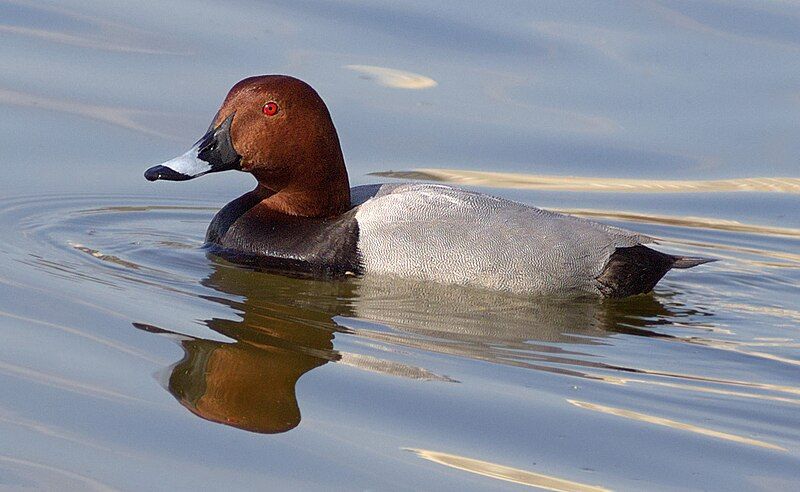
The common pochard is a medium-sized diving duck that is native to many parts of the world. The scientific name for this species is derived from two sources, the Greek language and Latin language.
The Greek word aithuia is an unidentified seabird mentioned by ancient authors such as Hesychius and Aristotle. The Latin word ferina translates to “wild game” and is derived from the Latin word ferus, which means “wild”.
These two sources combine to give the species its scientific name, Aythya ferina. The common pochard is a migratory species and can be found in a variety of habitats throughout the world.
They are particularly well-suited to life in wetlands, and they can be seen swimming, diving, and foraging in shallow water.
Their diet consists mainly of aquatic plants and small aquatic invertebrates. Common pochards have a distinctive brown body with a white head and neck and a black and white bill. They can grow up to 25 inches in length and have a wingspan of approximately 34 inches.
They have a loud, clucking call and are often seen in large flocks. The common pochard is a valuable species to many ecosystems, as they help to control the populations of aquatic invertebrates, which can otherwise become overabundant.
They are also an important food source for many other species. Despite this, their numbers are declining due to a variety of threats, including habitat loss and pollution. Conservation efforts are underway to help protect this species.
| Kingdom | Animalia |
| Phylum | Chordata |
| Class | Aves |
| Order | Anseriformes |
| Family | Anatidae |
| Genus | Aythya |
| Species | A. ferina |
13. Mute Swan
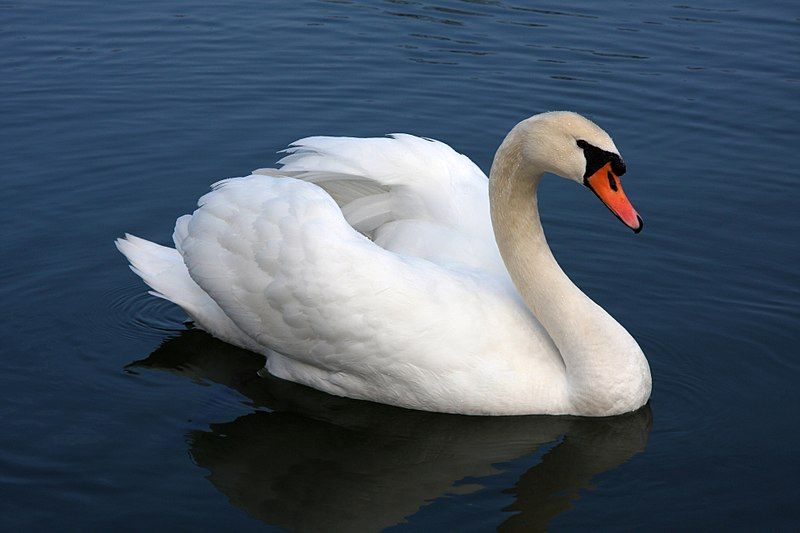
The mute swan is a species of swan found in Europe and parts of Asia and Africa. It is a member of the Anatidae family of waterfowl, which also includes ducks, geese, and swans. Mute swans are recognizable by their white feathers and long neck.
They can be found in wetlands, rivers, lakes, and ponds. Mute swans are native to much of Eurosiberia, which includes parts of Europe, Asia, and Siberia. They can also be found in the far north of Africa.
Mute swans prefer habitats with abundant vegetation and bodies of water, such as marshes, wetlands, rivers, lakes, and ponds. They are not migratory birds and usually stay in the same area year-round. Mute swans are omnivorous, eating both plants and animals.
Their diet includes aquatic plants, insects, mollusks, fish, and small amphibians. They also eat grains and seeds. Mute swans have strong legs and webbed feet that help them walk on land and swim in water. Mute swans are known for their grace and beauty.
They are also highly protective of their young and their territories. They can be aggressive towards humans and other animals if they feel threatened.
They are also very vocal, although they are called mute swans due to their lack of vocal ability compared to other species of swans.
| Kingdom | Animalia |
| Phylum | Chordata |
| Class | Aves |
| Order | Anseriformes |
| Family | Anatidae |
| Genus | Cygnus |
| Species | C. olor |
14. Garganey
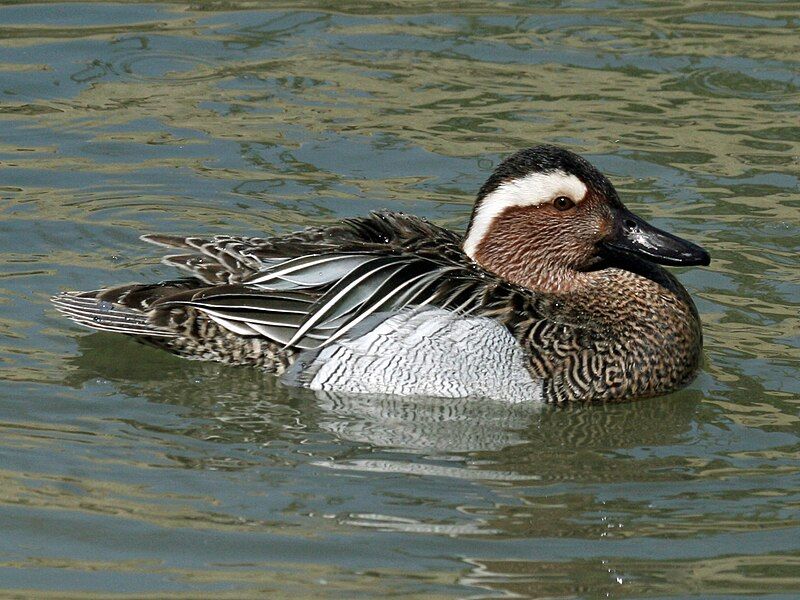
The garganey is a small dabbling duck that is found in many parts of Europe and across the Palearctic region. It breeds in these areas, but it is strictly migratory, meaning that the entire population will move south for the winter.
They travel to Africa, India, Bangladesh, and Australasia for the Northern Hemisphere winter. During this time, large flocks of these ducks can be seen in these areas.
This migration is an important part of the garganey’s life cycle, as it helps them find food and better climates during the colder months.
It also provides an opportunity for them to breed with other populations of garganey ducks, ensuring the health and diversity of the species as a whole.
| Kingdom | Animalia |
| Phylum | Chordata |
| Class | Aves |
| Order | Anseriformes |
| Family | Anatidae |
| Genus | Spatula |
| Species | S. querquedula |
15. Gadwall
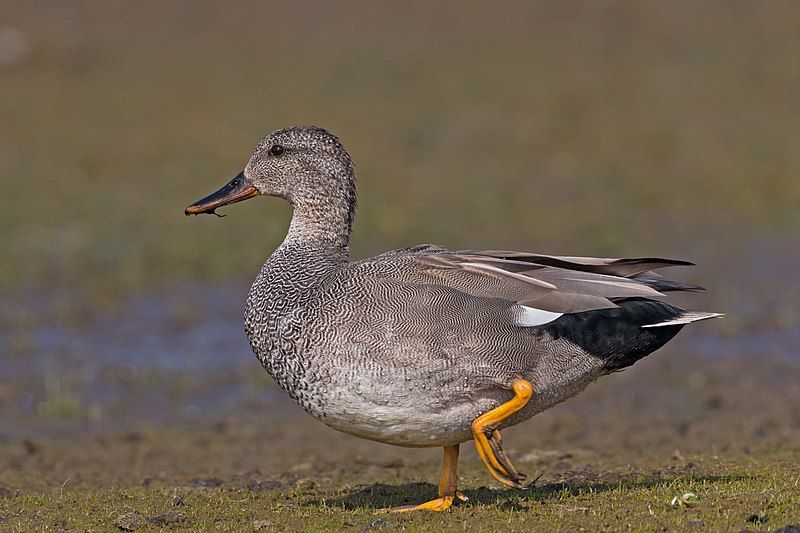
The gadwall is a type of duck that belongs to the family Anatidae. It is a dabbling duck, which means that it feeds by tipping forward in shallow water, scooping up food from the bottom.
The gadwall can be found in multiple areas across the globe, from Africa to Europe, Asia, North America, and South America. It is also quite widespread, being found in wetlands, rivers, lakes, reservoirs, and ponds.
The gadwall is a medium-sized duck with males having a body length of 20-24 inches, and females 18-22 inches. It has a greyish-brown body, white belly, and black-tipped wings. The male gadwall has a purplish-brown head with a white patch on the side and a bright yellow bill.
The female gadwall has a grey-brown head and a dull yellow bill. The gadwall usually feeds on seeds, aquatic plants, and insects. It is also a migratory species, flying south in winter to warmer climates and returning north in the summer.
It is an important species for hunting and has been hunted in many parts of the world. The gadwall is a species of conservation concern due to habitat loss and pollution.
It is listed as a species of least concern by the IUCN, but its population is still in decline in some areas. It is important to protect the gadwall’s habitat and ensure that its population remains stable.
| Kingdom | Animalia |
| Phylum | Chordata |
| Class | Aves |
| Order | Anseriformes |
| Family | Anatidae |
| Genus | Mareca |
| Species | M. strepera |
16. Common Merganser
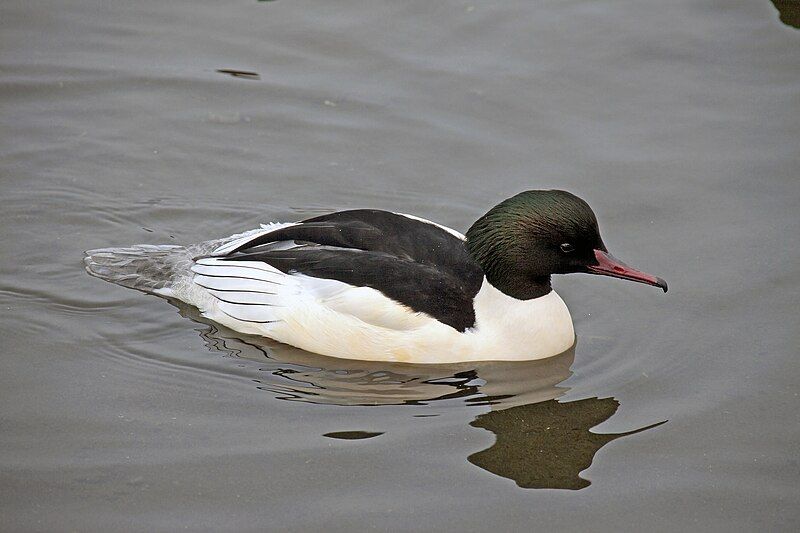
The Common Merganser, also known as the Goosander, is a species of large duck living primarily in rivers and lakes in woodlands and forests. This species of duck has a large range, spanning Europe, Asia, and North America. It is an omnivore but mainly eats fish.
The Common Merganser builds its nest in holes in trees, which helps to hide it from predators. This species is a very adaptive bird and can survive in a variety of habitats. The Common Merganser is a unique species and is an important part of the local ecology.
It is an important part of the food chain, as it feeds on fish and other aquatic organisms, thus helping to keep the local ecosystem in balance. Furthermore, it is also a great source of food for many other species, such as birds of prey, which rely on it for sustenance.
The Common Merganser is an important species that deserves our protection and appreciation.
| Kingdom | Animalia |
| Phylum | Chordata |
| Class | Aves |
| Order | Anseriformes |
| Family | Anatidae |
| Genus | Mergus |
| Species | M. merganser |
17. Ardea Alba
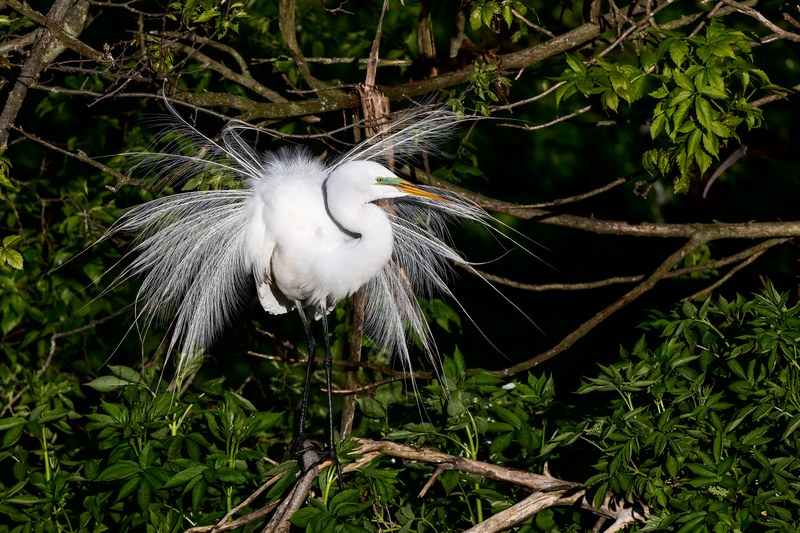
The great egret is a species of heron that is found in many areas around the world. It is also referred to as the common egret, large egret, or great white egret or great white heron.
This species is quite widespread, with four subspecies found in Asia, Africa, the Americas, and southern Europe.
In recent years, it has been observed to be spreading to more northern areas of Europe, indicating that its population is growing and its range is expanding. The great egret is a large bird that stands at around three feet in height.
It has white feathers and a long neck, and a wingspan of up to five feet. Its long legs are yellow in color and it has a yellow bill.
This species is often seen wading in shallow water, searching for food such as fish, amphibians, and insects. Great egrets are generally considered to be a species of least concern, as they have a large global population with no obvious threats to their survival.
However, they are vulnerable to habitat destruction and disturbance, as well as being hunted for their feathers and skins.
It is therefore important to ensure that their habitats are protected, in order to maintain their current population and allow them to continue to spread to more areas.
| Kingdom | Animalia |
| Phylum | Chordata |
| Class | Aves |
| Order | Pelecaniformes |
| Family | Ardeidae |
| Genus | Ardea |
| Species | A. alba |
18. Greylag Goose
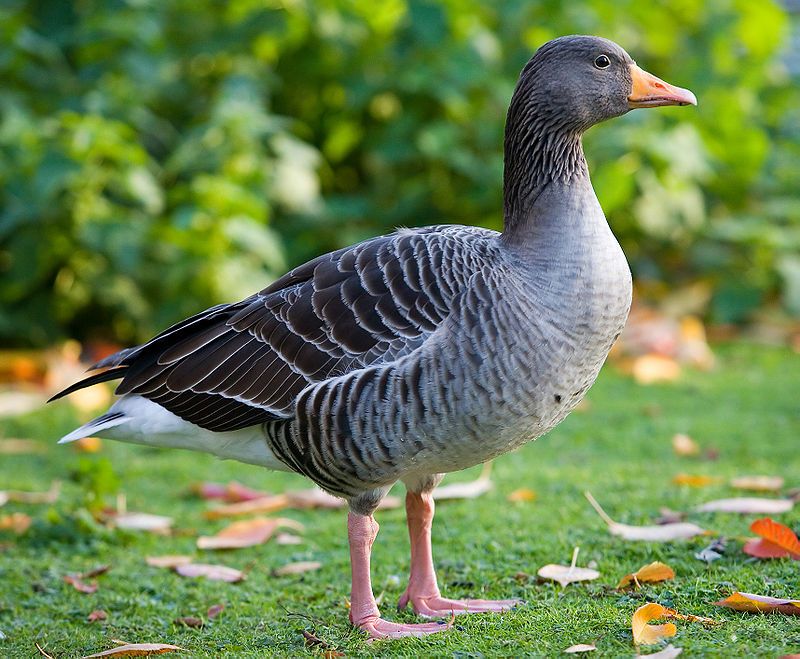
The Greylag Goose, also known as the Graylag Goose, is a species of large goose that belongs to the waterfowl family Anatidae. It is also the type species of the genus Anser.
This bird has a unique appearance, with its plumage consisting of mottled grey and white stripes, and its beak and legs being orange and pink in color, respectively. It breeds in a variety of habitats, including wetlands, grasslands, and even agricultural areas.
The Greylag Goose is widely distributed across Europe, Asia, and North Africa, and is also seen in parts of North America. In Europe, it is the largest and most common goose species and is often seen in large flocks.
It feeds mainly on plants, such as grasses, grains, and aquatic vegetation, but will sometimes take small invertebrates. The Greylag Goose is a social species, and pairs can often be seen flying and foraging together.
Breeding usually occurs from April to June, and the female lays two to six eggs. The young hatch after about a month, and are cared for and fed by both parents. The Greylag Goose is a well-known species, and its population is currently stable.
| Kingdom | Animalia |
| Phylum | Chordata |
| Class | Aves |
| Order | Anseriformes |
| Family | Anatidae |
| Genus | Anser |
| Species | A. anser |
19. Common Goldeneye
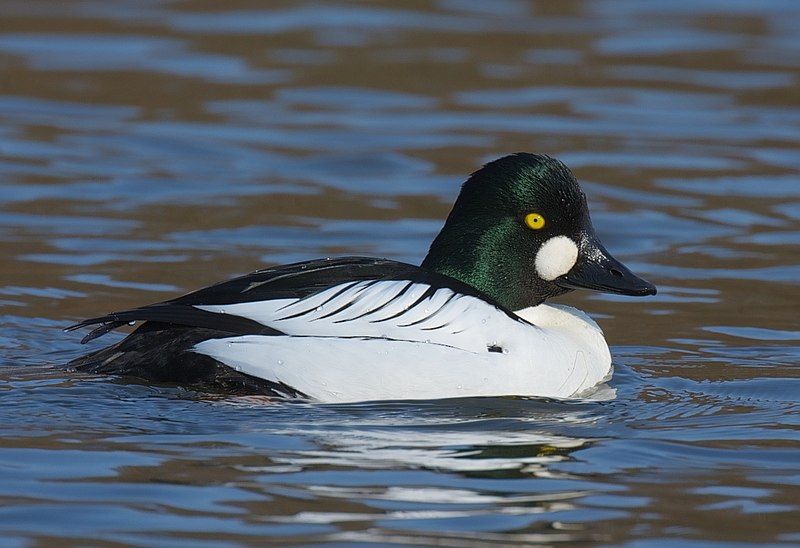
The common goldeneye is a medium-sized sea duck found in the genus Bucephala, also known as the goldeneyes. It is closely related to Barrow’s goldeneye, which is similar in appearance.
The name of the genus, Bucephala, is derived from the Ancient Greek boukephalos which means “bulbous head”. This refers to the shape of the head of the bufflehead, a type of sea duck that is closely related to the goldeneye.
The common goldeneye is known for its distinctive black and white markings, as well as its bright yellow eyes which give it its name. The goldeneye is a strong swimmer and can dive up to depths of sixty feet in search of food.
It is a migratory species and can be found in coastal areas during the winter months. The goldeneye is an important part of the ecosystem, as it feeds on a variety of fish and crustaceans and in turn is a food source for predators such as eagles and owls.
| Kingdom | Animalia |
| Phylum | Chordata |
| Class | Aves |
| Order | Anseriformes |
| Family | Anatidae |
| Genus | Bucephala |
| Species | B. clangula |
20. Common Scoter
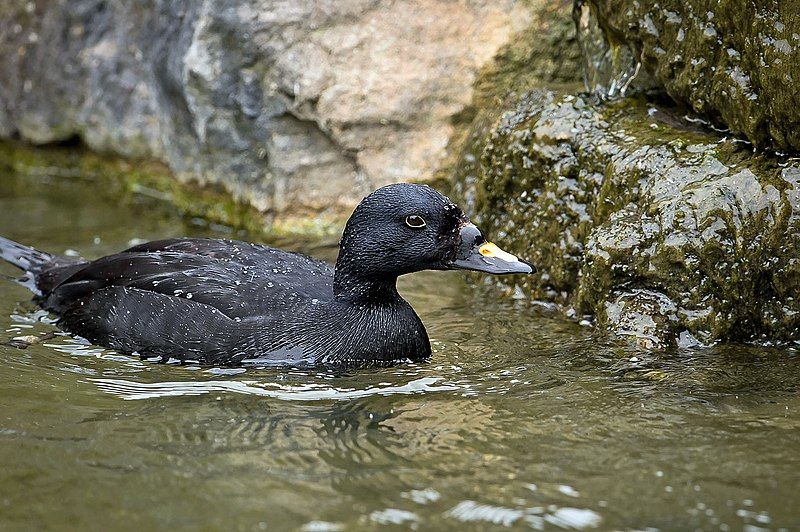
The Common Scoter is a type of large sea duck that is found in areas located in the far north of Europe and the Palearctic, which stretches east to the Olenyok River. It has an average length of 43–54 cm, making it a rather large bird.
The genus name of the species derives from Ancient Greek, with melas meaning “black” and Netta meaning “duck”. The species name is from Latin, with niger meaning “shining black”, which accurately describes the bird’s feathers.
This species of duck is a beautiful sight, its feathers reflecting off the sun to give it a shining black appearance. It is also quite a rare species, mainly found in the far north of Europe and the Palearctic.
| Kingdom | Animalia |
| Phylum | Chordata |
| Class | Aves |
| Order | Anseriformes |
| Family | Anatidae |
| Genus | Melanitta |
| Species | M. nigra |
21. Grey Partridge
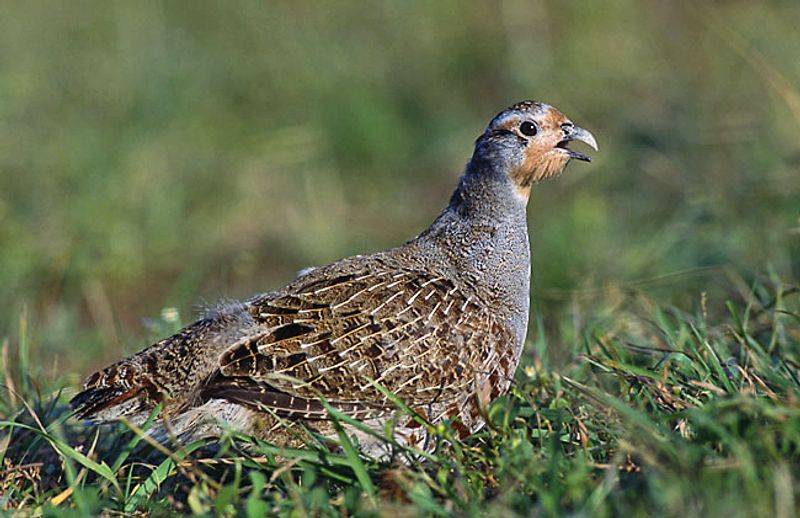
The grey partridge is a species of game bird in the pheasant family, Phasianidae. It has a range of common names, including gray-legged partridge, English partridge, Hungarian partridge, and hun. The scientific name for this bird is perdix, which is derived from Ancient Greek.
It belongs to the order Galliformes, which consists of gallinaceous birds. The grey partridge is native to Eurasia and parts of North Africa. It is a medium-sized bird, typically with a grey back and head, and mottled brown and white underparts.
It has a slim pointed bill and short legs. The male and female are similar in appearance, although the male has a larger bill and tail. The grey partridge is an omnivore, eating mainly seeds and insects. The grey partridge is a popular gamebird and is often hunted for sport.
It is one of the most common species of partridge and is typically found in farmland and grassland habitat. The grey partridge is also a popular bird in aviculture, although its numbers in the wild have declined due to loss of habitat and hunting pressure.
Conservation efforts are underway to protect the species and its habitat.
| Kingdom | Animalia |
| Phylum | Chordata |
| Class | Aves |
| Order | Galliformes |
| Family | Phasianidae |
| Genus | Perdix |
| Species | P. perdix |
22. Common Moorhen
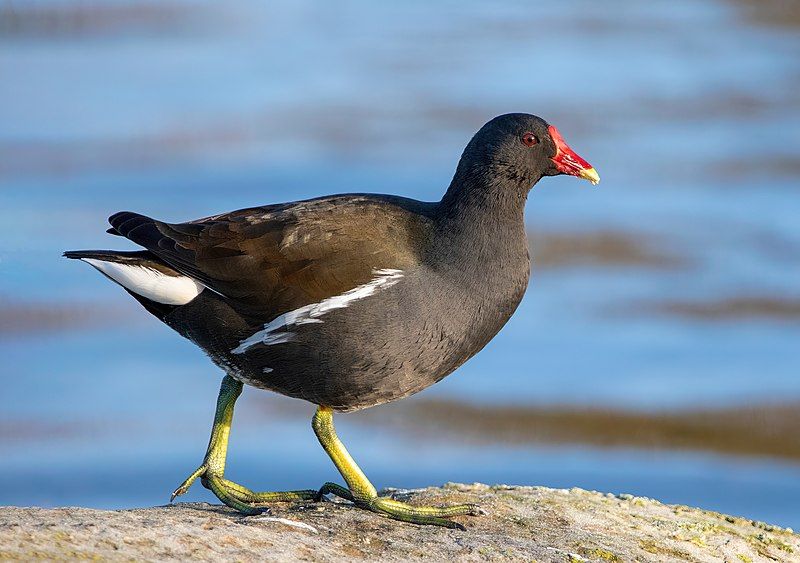
The common moorhen, also known as the waterhen or swamp chicken, is a bird species that belongs to the rail family. It can be found in many parts of the Old World, ranging from Europe to Asia, and even in parts of Africa.
The common moorhen is a semi-aquatic bird, and it typically lives in areas with plenty of vegetation. It can be found in and around marshes, ponds, canals, and other wetlands. It is a strong swimmer and has partially webbed feet that help it move through the water with ease.
The common moorhen is a medium-sized bird, with a body length of around 30 cm. It is generally brownish-grey in colour, with a white line running from its bill to the sides of its neck.
Its bill is yellow in colour, while its legs are greenish-yellow. The common moorhen is omnivorous and feeds mainly on aquatic plants, as well as small invertebrates. It will also occasionally feed on small vertebrates, such as frogs and fish.
The common moorhen is territorial and will often chase away intruders from its territory. During courtship, it will perform a variety of displays, including chasing and calling. The common moorhen is a ground-nesting bird.
It builds its nest out of grass and reeds and usually lays between four and eight eggs. Both the male and female will take turns incubating the eggs and caring for the young chicks.
| Kingdom | Animalia |
| Phylum | Chordata |
| Class | Aves |
| Order | Gruiformes |
| Family | Rallidae |
| Genus | Gallinula |
| Species | G. chloropus |
23. White Stork
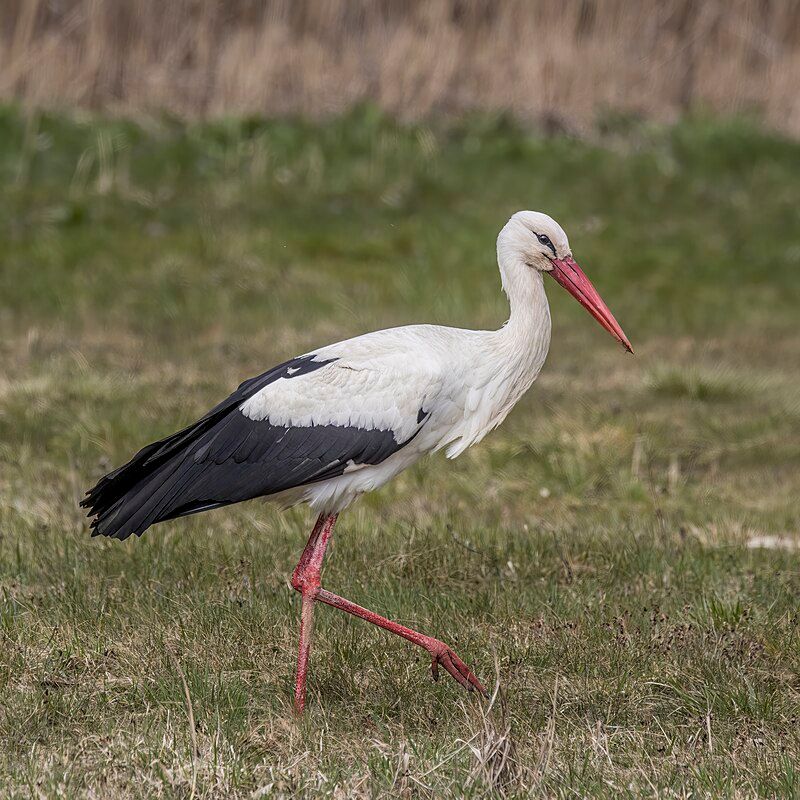
The white stork is a large bird that belongs to the Ciconiidae family. This bird has a white plumage which is contrasted by the black feathers on its wings. The adult stork has striking red legs and a long, pointed beak.
Its average size is about 100–115 cm from the tip of its beak to the end of its tail, and its wingspan is roughly 155–215 cm. The white stork is an imposing sight, with its large size and bright red colouring.
This bird is a long-distance migratory species, travelling thousands of kilometers each year in order to find food and suitable nesting sites. Storks are known for their loyalty, often returning to the same nesting site year after year.
They are an important part of the ecosystem, feeding upon a variety of small animals and helping to keep the environment in balance.
| Kingdom | Animalia |
| Phylum | Chordata |
| Class | Aves |
| Order | Ciconiiformes |
| Family | Ciconiidae |
| Genus | Ciconia |
| Species | C. ciconia |
24. Common Gull
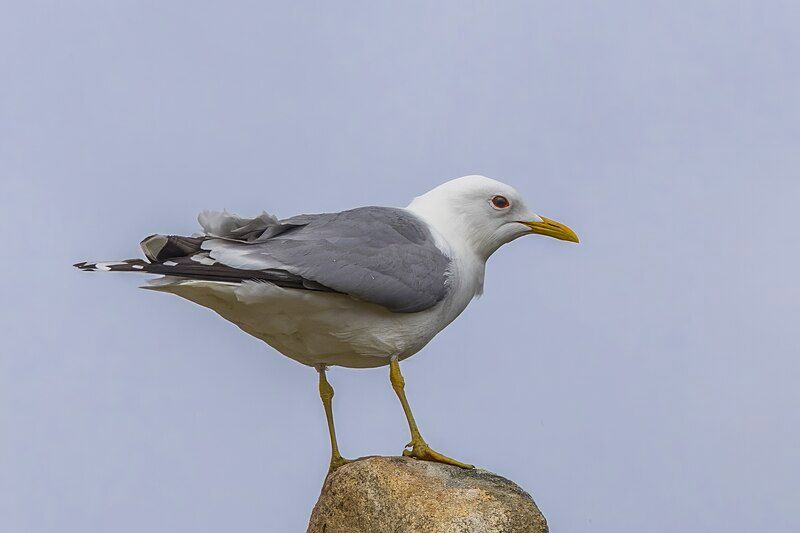
The common gull, also known as the sea mew, is a species of medium-sized gull that lives primarily in the Palearctic region of northern Europe. It is closely related to the short-billed gull, and both of these species are sometimes referred to collectively as the “mew gull”.
During the winter months, many common gulls migrate to warmer climates, usually further south. This is likely due to the colder temperatures and food availability, as the birds need to stay warm and nourished in order to survive.
These migrations are an essential part of the life cycle of the common gull and allow the species to thrive in a variety of climates and environments.
| Kingdom | Animalia |
| Phylum | Chordata |
| Class | Aves |
| Order | Charadriiformes |
| Family | Laridae |
| Genus | Larus |
| Species | L. canus |
Conclusion
The birds of Reggio Calabria are a varied and fascinating array of species that offer visitors and locals alike an amazing variety of birds to observe and appreciate.
From the many species of migratory birds that winter in the region to the resident species that call the region home all year round, the birds of Reggio Calabria are a truly unique part of the natural environment of the region.
With its diverse habitats, the region provides a wonderful opportunity for birders to enjoy and appreciate the wonderful variety of birds that inhabit the region.